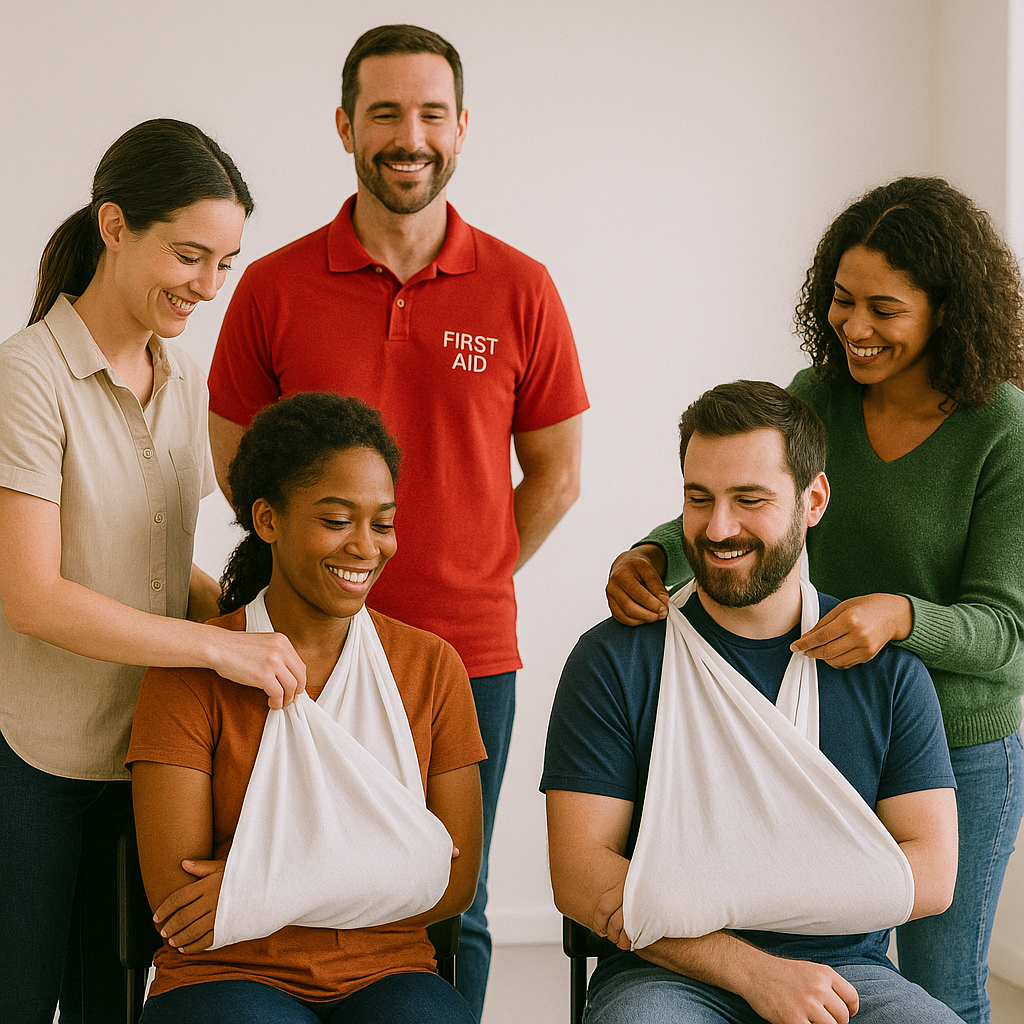Training and Assessment Delivered on Behalf of Allens Training Pty Ltd RTO 90909
“A Sling is a Sling… Right?”

Understanding the Different Types of Slings and When to Use Them
What is a Sling?
- Prevent movement of the injured area
- Reduce pain and swelling
- Support the limb while awaiting medical attention
Types of Slings and When to Use Them
1. Standard Arm Sling
- Place the triangular bandage under the forearm with the point toward the elbow.
- Bring the upper ends up around the neck and tie securely.
- The elbow should be tucked neatly into the sling, with fingers visible for circulation checks.
Top tip: The sling should raise the hand just above heart level to help reduce swelling.
2. Elevated (High) Arm Sling
- Fold the triangular bandage around the wrist or hand.
- Tie the ends behind the neck so the hand is supported high.
- Use a second bandage around the body to secure the arm if needed.
Top tip: Always ensure the knot behind the neck is padded or placed on the uninjured side to avoid strain.
3. Collar and Cuff Sling
- Use a narrow bandage to form a loop around the wrist.
- Tie the other end around the neck.
- Adjust so the hand hangs at a comfortable height.
Top tip: Keep the hand slightly forward from the hip, not swinging free at the side.
How to Check for Circulation in an Injured Arm
- Look: Are the fingers turning pale or blue?
- Feel: Are the fingers cold compared to the other hand?
- Move: Can the person still wiggle their fingers?
- Pinch test: Press a fingernail until it turns white, then release. Colour should return within 2 seconds. Test on the uninjured side and compare.
If there are any signs of restricted circulation, loosen the sling slightly and recheck.
Quick Comparison – Types of Slings at a Glance
| Sling Type | Best For | Position | Key Benefit |
|---|---|---|---|
| Standard Arm Sling | Wrist, forearm injuries | Across chest, elbow bent | Basic support and comfort |
| Elevated Arm Sling | Collarbone or shoulder injuries | Hand higher than elbow | Reduces swelling, restricts movement |
| Collar and Cuff Sling | Upper arm fractures | Hanging vertically from wrist | Gravity assists alignment |
Improvised Slings: What to Use When You Don’t Have a Bandage
If you’re caught without a first aid kit, you can make an effective sling using:
- A clean scarf or towel
- A T-shirt or jumper
- Any strong, soft fabric
- Even a shopping bag in a pinch
Just make sure to support the weight of the arm, avoid knots directly on injuries, and regularly check for signs of circulation issues.
Common Mistakes to Avoid
- Tying the sling too tight around the neck
- Letting the arm hang unsupported
- Forgetting to check for swelling or circulation
- Using the wrong sling type for the injury
If in doubt, immobilise gently and seek medical advice.
When to Seek Professional Help
Slings are for temporary support only. Always seek medical attention if:
- You suspect a fracture or dislocation
- There is swelling, bruising or visible deformity
- The person is in significant pain
- There is loss of movement or feeling
- The injury was caused by a fall, impact or trauma
Want to Learn How to Apply a Sling Properly?
We cover sling techniques, fracture support and full injury management in our HLTAID011 – Provide First Aid course. You’ll get hands-on training with real bandages — and leave with the confidence to act when someone needs you.
Final Thoughts…
So… is a sling just a sling?
Not quite.
The type of sling you choose — and how you apply it — can make a huge difference in comfort, safety, and recovery. With a little knowledge and practice, you can turn a simple bandage into powerful first aid.

